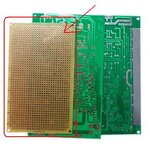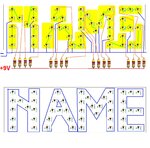een54
Newbie level 5
Hello all,
I am completly new to electronics, save for attaching a light bulb to a battery using crocodile clips back in school.
I wanted to make a gift for someone using LED's to spell out their name in a picture frame.
Something like this to give you an idea:
|----------------------|
| N A M E ' S |
| |
| R O O M | The frame messes up when I submit but just imagine the dashes as a picture frame
| |
| |
|_______________ |
I would like the letters to be spelled out in LED's and possibly flash but not if this is going to be too difficult for a first timer.
Also would it be better to power this by battery or by a plug into the wall?
I would like this to be around 30cm by 60cm but the size really isnt important.
Can anyone give me details on what I would need, how I would go about it, and whether this is going to be possible at all?
I have access to a Soldering Iron and solder. And I have been looking at buying LED's on Ebay. I've done some research and I know I will need resistors but im unsure what type or which ones.
Thank you in advance for any help I receive and apologies if this is the wrong forum, but I thought this one looked like one for asking for help.
een
I am completly new to electronics, save for attaching a light bulb to a battery using crocodile clips back in school.
I wanted to make a gift for someone using LED's to spell out their name in a picture frame.
Something like this to give you an idea:
|----------------------|
| N A M E ' S |
| |
| R O O M | The frame messes up when I submit but just imagine the dashes as a picture frame
| |
| |
|_______________ |
I would like the letters to be spelled out in LED's and possibly flash but not if this is going to be too difficult for a first timer.
Also would it be better to power this by battery or by a plug into the wall?
I would like this to be around 30cm by 60cm but the size really isnt important.
Can anyone give me details on what I would need, how I would go about it, and whether this is going to be possible at all?
I have access to a Soldering Iron and solder. And I have been looking at buying LED's on Ebay. I've done some research and I know I will need resistors but im unsure what type or which ones.
Thank you in advance for any help I receive and apologies if this is the wrong forum, but I thought this one looked like one for asking for help.
een



